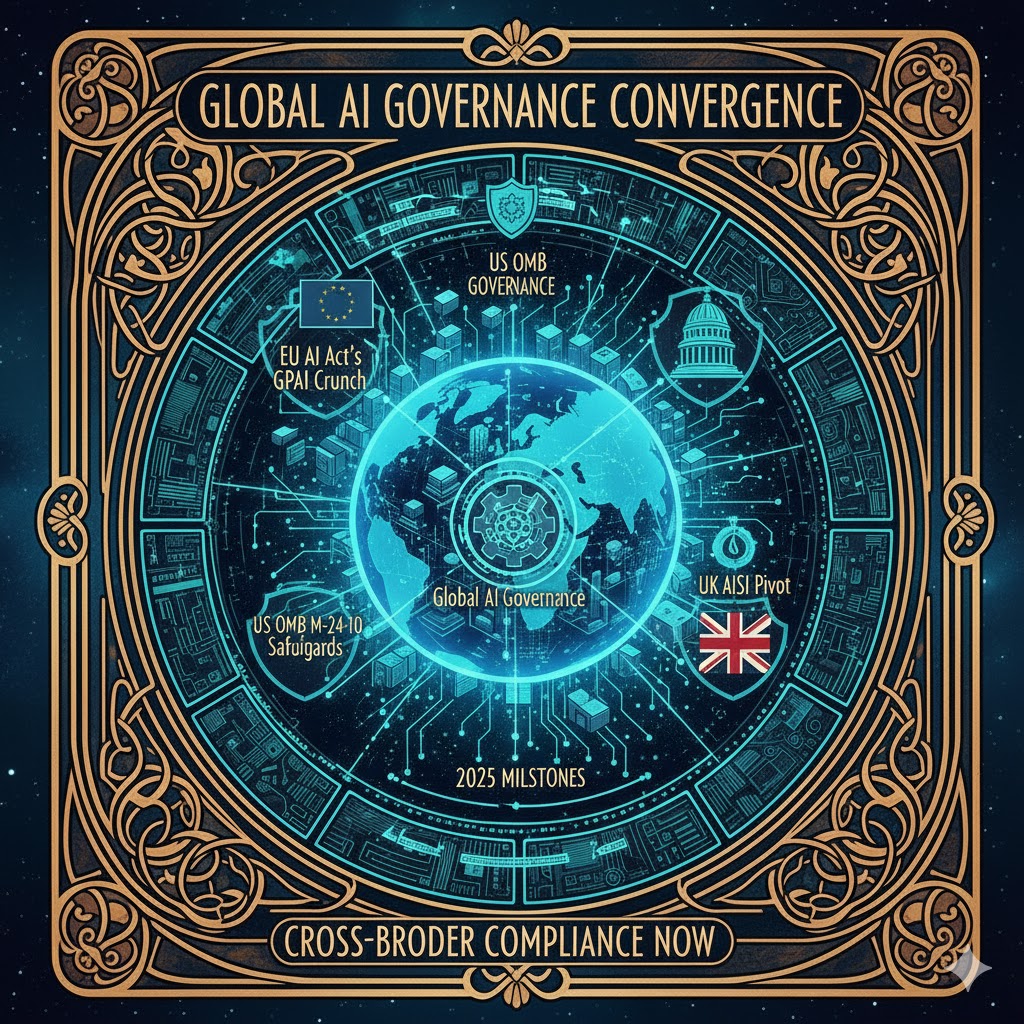Executive Summary
The rapid proliferation of artificial intelligence (AI) technologies has triggered a global wave of regulatory action. Key milestones to note: the EU’s first-of-its-kind horizontal regulatory framework for AI (the EU AI Act) entered into law in 2024, the U.S. federal government issued sweeping guidance on agency AI governance via OMB Memorandum M-24-10 in early 2024, and in the UK the newly renamed AI Security Institute (formerly Safety Institute) is advancing technical evaluation regimes for advanced AI models.
For companies that develop, deploy, procure or embed AI systems — especially those operating internationally or serving government customers — these developments carry urgent implications. They introduce new obligations around risk-classification, transparency, documentation, human oversight, procurement practices, and cross-border supply chain compliance. At the same time, they also reflect the opportunity to align AI implementation with trust, safety, accountability and market access.
This white paper maps the regulatory terrain, highlights actionable implications, and provides a framework of recommended actions for organisations seeking to prepare for and benefit from this shift.
Background: Why Now?
AI systems are increasingly embedded in critical domains — from healthcare diagnostics and policing to credit-scoring, hiring, and industrial automation. This has prompted regulators globally to shift from voluntary guidance to formal rules.
EU: The EU AI Act
The EU AI Act represents the first comprehensive horizontal legislation on AI. The regulation uses a risk-based categorisation of AI systems (from unacceptable risk, high risk, limited risk, to minimal risk) and imposes obligations on both providers and deployers (including non-EU entities supplying into the EU) to ensure safety, transparency, human oversight and fundamental-rights protection. modelop.com+3Digital Strategy+3ISACA+3
For example, the Act emphasises transparency and explainability, and requires that humans be aware when interacting with AI, and that systems’ capabilities and limitations are disclosed. protiviti.com+1
U.S.: OMB Memorandum M-24-10
In the U.S., at the federal-agency level, OMB issued M-24-10 (March 2024) which sets out minimum risk-management practices for AI systems that impact rights or safety — including the requirement to catalogue AI use cases, create governance bodies (e.g., a Chief AI Officer) and develop compliance/mitigation plans. The White House+2Digital Government Hub+2
Although this is specific to federal agencies, the procurement and vendor ecosystem is affected (vendors to government must align).
UK & Advanced Model Evaluation
In the UK, the re-branded AI Security Institute is building frameworks for evaluation of advanced AI and model capability/security work (e.g., for large language models). This reflects a growing global regime for “frontier AI” governance.
Impetus & International Reach
These regulatory moves are not isolated. The EU framework has extra-territorial reach (non-EU providers may be captured if supplying into the EU) and establishes a benchmark regulators in other jurisdictions are likely to reference. modelop.com+2Digital Strategy+2
Hence, organisations that operate globally (or that supply into regulated markets) must treat this as more than a local compliance exercise — this is a globally shifting AI governance landscape.
Key Milestones & Timelines
| Region / Framework | Key Dates & Milestones | Key Features / Obligations |
|---|---|---|
| EU – EU AI Act | • Enters into force: 1 August 2024. White & Case+1 • Many obligations and high-risk rules: effective from 2 August 2026. White & Case+1 • Some time-phased/more advanced model rules around 2 August 2027 for embedded high-risk systems. White & Case+1 | Risk-based classification of AI systems; prohibition of unacceptable-risk uses; obligations for high-risk systems (data governance, documentation, human oversight); general-purpose AI model provider obligations; transparency, accountability. protiviti.com+1 |
| U.S. – OMB M-24-10 | • Issued 28 March 2024. Digital Government Hub+1 • U.S. agencies required to publish AI compliance plans, catalogue AI use cases, implement governance. cio.gov+1 | Governance (Chief AI Officer, AI governance board), inventory of AI use cases, minimum risk-management practices for rights/safety-impacting AI systems, procurement guidance. hunton.com |
| UK / Model Evaluation | • Establishment/renaming of AI Security Institute (formerly Safety Institute) and partnerships (e.g., with OpenAI) to evaluate advanced AI models. (Date: Feb 2025 re-branding) | Focus on security evaluation, testing model capability, assessing advanced generative/LLM systems, building infrastructure for evaluation. |
| Supplier / Global Impact | • Entities serving EU or U.S. government/procurement markets must align • “Brussels effect”: EU standards influencing global companies and supply chains | Cross-border compliance, dual-regime (EU & U.S.) considerations, vendor obligations, documentation, audits, risk-controls across markets |
Implications for Organisations
From a business and operational perspective, these regulatory developments raise multiple implications for organisations that build, deploy or procure AI systems. Below are key areas to watch.
1. Roles & Responsibilities: provider vs deployer vs importer/distributor
Under the EU framework, different actors have distinct obligations. For example, a “provider” (developer of an AI system) and a “deployer” (entity making the system available) bear different responsibilities. ISACA+1 Organisations must map their role(s) in the AI lifecycle (development, deployment, distribution) and determine which obligations apply.
2. Risk-based classification & segmentation
The EU AI Act’s risk-based approach means that obligations are not uniform: “unacceptable risk” uses (e.g., certain social-scoring by governments) are banned; “high-risk” uses (e.g., AI for critical infrastructure, health, employment) carry onerous obligations; “limited-risk” and “minimal-risk” carry proportionate lighter duties. modelop.com Organisations must categorise their AI systems accordingly and determine the compliance implication.
3. Documentation, transparency & human oversight
High-risk systems under the EU Act must meet requirements such as: risk-management systems, training-data governance, technical documentation, human oversight, post-market monitoring. iks.fraunhofer.de+1 In the U.S., the memo emphasises governance, inventory of uses, and risk controls. Failure to meet these requirements may limit market access, lead to enforcement, reputational risk or litigation.
4. Procurement and vendor/supply-chain impact
In the U.S., agencies must ensure procurement practices for AI systems include vendor risk assessments and contractual terms on IP, data, rights, performance. Covington & Burling For companies that supply AI to government or to entities operating in regulated markets, adherence to procurement-grade safety and governance becomes a differentiator and a compliance necessity.
5. Cross-border / extraterritorial reach
Because the EU Act applies to importers/distributors and to non-EU entities supplying into the EU — and because many global-scale AI systems are developed outside Europe — there is a “Brussels effect” where global firms must align globally to satisfy EU obligations. modelop.com Likewise, U.S. vendor obligations feed into global supply-chains. Organisations need to adopt global governance (rather than piecemeal local) to avoid fragmentation.
6. Timing & Transitional Imperative
With phased enforcement dates (e.g., EU high-risk rules 2026, U.S. agency deadlines Rolling) organisations need to plan ahead. Companies that wait until last minute may face bottlenecks, higher cost, or delayed market access. According to one U.S. review, many agencies failed to meet initial plan-publication deadlines under M-24-10. epic.org
7. Competitive & Strategic Opportunity
Complying early can yield strategic advantage: trust and transparency become market differentiators in B2B/enterprise sales; governments increasingly prefer suppliers with strong AI governance; reputational risk is mitigated; better risk-management leads to fewer adverse incidents. In sum — this is not purely a compliance cost, but a business enabler.
Recommended Actions / Framework
Here is a practical framework organisations should adopt to prepare for and respond to this shifting regulatory environment:
- Conduct an AI-Inventory & Role Mapping
- Catalogue all current and planned AI systems: what they do, which data they use, whether they impact rights or safety, regions of deployment.
- Map your organisation’s role for each system (developer/provider, deployer/distributor, importer, etc).
- Identify cross-border supply-chain links (e.g., if you supply into the EU or U.S. government markets).
- Perform a Risk-Classification & Impact Assessment
- Determine for each system whether it falls into “minimal”, “limited”, “high”, or “unacceptable” risk (or relevant local variant).
- For high-risk systems, perform a Fundamental Rights Impact Assessment (EU) or equivalent rights/safety-impact analysis (U.S.).
- Identify external dependencies (third-party models, data, vendors) and potential vulnerabilities (bias, robustness, explainability, privacy).
- Governance & Accountability Setup
- Establish an AI governance body (e.g., under a Chief AI Officer) with defined oversight across strategy, risk, compliance. (Mirrors U.S. agency obligations). ahima.org
- Define roles and responsibilities for provider and deployer functions, documentation archiving, monitoring & reporting.
- Develop policies for vendor/supply-chain management, audit trails, documentation retention.
- Technical & Documentation Infrastructure
- Implement risk-management workflows: identify risks, assess, mitigate, monitor, update.
- For high-risk systems: document training data (quality, provenance, bias assessment), model architecture, testing/validation (robustness, performance, safety), human oversight mechanisms. iks.fraunhofer.de+1
- Ensure transparency: logs of use, explainability where relevant, notifications when interacting with AI (where required by law).
- Prepare for conformity assessment (for the EU high-risk systems) and audit readiness. onetrust.com
- Procurement & Vendor Contracts
- If supplying AI or procured for internal use, ensure contracts include clauses on data rights, IP, audit access, logging, performance guarantees, monitoring of drift, incident-reporting obligations. (U.S. procurement trend) Covington & Burling
- Vendors should be ready to provide governance documentation, transparency disclosures, risk-assessment summaries to customers, especially in regulated markets.
- Cross-Jurisdictional Alignment
- Create a unified compliance program that can scale globally rather than country-by-country. For example, apply EU high-risk governance globally rather than only in EU deployment — this simplifies operations and avoids fragmentation.
- Monitor regulatory developments in key jurisdictions (EU, U.S., UK, etc.), and maintain a regulatory-watch function to update policies.
- Training, Culture & Monitoring
- Develop internal training on AI ethics, governance, regulatory obligations, human oversight.
- Monitor deployed systems continuously for drift, bias, unintended consequences, incidents. Establish incident-response processes.
- Maintain documentation of monitoring and remediation activities as part of audit trail.
- Strategic Positioning & Communication
- Use compliance and governance as a competitive advantage: promote trust to customers, partners, regulators.
- For public sector vendors: emphasise readiness for government procurement, certifications or compliance evidence.
- Consider strategic alignments: e.g., adoption of voluntary codes of practice may ease regulatory burden (EU general-purpose AI code forthcoming).
Conclusion
The convergence of global AI-governance regimes — led by the EU AI Act, U.S. federal agency mandates under OMB M-24-10, and active model-evaluation programmes in the UK — marks a turning point for organisations building, deploying or procuring AI. What was previously a frontier of experimentation and self-regulation is moving into the domain of formalised governance, documentation, risk management and accountability.
For organisations that act now — mapping their systems, aligning their governance, investing in documentation and transparency, and preparing their procurement/supply-chain-to comply — this is an opportunity: not just to avoid regulatory risk, but to differentiate on trust, readiness and global market access.
On the flip side, organisations that delay or treat this as a “nice to have” will face mounting risks: slower market access (especially into the EU or public-sector contracts), higher compliance cost at the last minute, reputational and legal exposure. The message is: this is not optional.
Given your work at [your domains / trust-building content], embedding this regulatory narrative into your AI strategy, content or offerings (for your audiences, clients or internal stakeholders) can position you ahead of the curve. If you like, I can generate a downloadable PDF white-paper template (with brand placeholders) that you can adapt or publish. Would you like me to build that?









